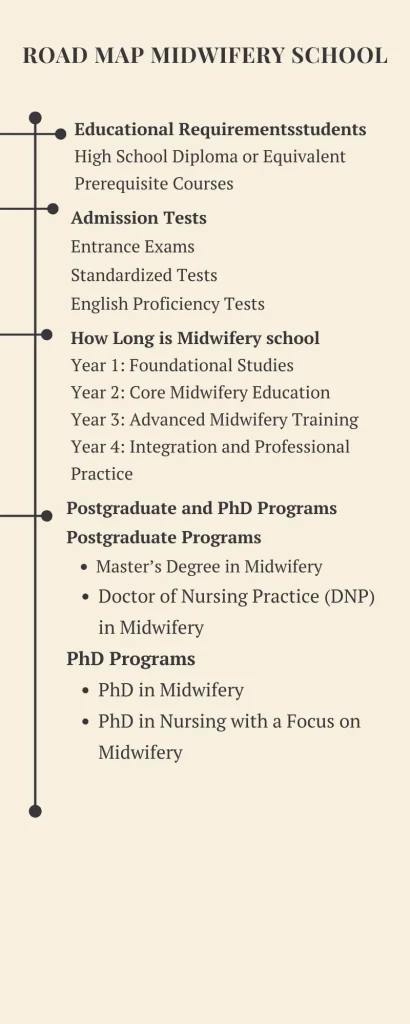How Long is Midwifery School? The duration of midwifery school typically ranges from two to four years, depending on the program and level of education pursued. Students often need to complete a bachelor’s degree followed by a specialized midwifery program. This ensures they gain the necessary knowledge and clinical experience to become certified midwives.
What is Midwifery School
Midwifery school is a specialized educational program designed to train individuals in the practice of midwifery. These programs offer comprehensive coursework in prenatal care, childbirth, postpartum care, and neonatal health. Students learn through a combination of classroom instruction and hands-on clinical experience, ensuring they are well-prepared to support women during pregnancy, labor, and delivery.

In midwifery school, students also gain knowledge in women’s health, reproductive health, and primary care. The curriculum often includes subjects like anatomy, physiology, pharmacology, and emergency care, along with training in communication and counseling. This holistic approach equips future midwives with the skills needed to provide compassionate, evidence-based care to women and newborns.
How Long is Midwifery School
Year 1: Foundational Studies
Coursework: In the first year, students typically focus on foundational courses in health sciences, including anatomy, physiology, biology, and introductory courses in midwifery.
Skills: Basic medical skills, understanding of normal pregnancy and childbirth, introduction to professional practice, and patient communication.
Experience: Limited hands-on experience, primarily observational or simulation-based.
Year 2: Core Midwifery Education
Coursework: The second year delves deeper into specialized subjects such as prenatal care, labor and delivery, postpartum care, and neonatal care.
Skills: Development of more advanced clinical skills, understanding complications during pregnancy and childbirth, and learning about maternal and newborn health.
Experience: Supervised clinical placements begin, where students start to observe and assist in real-life settings under the guidance of experienced midwives.
Year 3: Advanced Midwifery Training
Coursework: Advanced courses in gynecology, obstetrics, and reproductive health, along with pharmacology and emergency care for midwives.
Skills: Proficiency in handling complex cases, emergency interventions, and comprehensive patient care planning.
Experience: Increased clinical placements, including rotations in hospitals, birthing centers, and community health settings, with a focus on gaining hands-on experience in delivering babies and providing postpartum care.
Year 4: Integration and Professional Practice
Coursework: Final year emphasizes integration of knowledge and skills, with courses in leadership, ethics, and healthcare systems.
Skills: Preparation for independent practice, advanced clinical decision-making, and development of professional competence.
Experience: Extensive clinical placements, often including a capstone project or thesis, where students take on more responsibility and work closely with midwives to gain practical experience and confidence.

How to Enter Midwifery School
Educational Requirements:
High School Diploma or Equivalent: A high school diploma or GED is typically required.
Prerequisite Courses: Completion of prerequisite courses in biology, chemistry, and health sciences is often necessary.
Bachelor’s Degree: Some programs may require a bachelor’s degree in a related field such as nursing, health sciences, or a similar discipline.
Entry Tests:
Standardized Tests: Depending on the program, applicants might need to take standardized tests like the SAT or ACT for undergraduate entry.
Entrance Exams: Some midwifery programs may require specific entrance exams such as the TEAS (Test of Essential Academic Skills) or other institution-specific tests.
English Proficiency Tests: For non-native English speakers, tests like the TOEFL or IELTS may be required.
Application Process:
Research Programs: Identify accredited midwifery programs that match your educational background and career goals.
Application Form: Complete the application form available on the school’s website.
Transcripts: Submit official transcripts from high school and any post-secondary education.
Letters of Recommendation: Provide letters of recommendation from teachers, employers, or healthcare professionals.
Personal Statement: Write a personal statement outlining your interest in midwifery, career goals, and any relevant experience.
Resume/CV: Include a resume or CV detailing your educational background, work experience, and relevant skills.
Interviews: Some programs may require an interview as part of the selection process.
Financial Aids:
Scholarships: Many schools offer scholarships based on academic merit, financial need, or specific criteria related to midwifery.
Grants: Federal and state grants, such as the Pell Grant, can provide financial assistance based on need.
Loans: Federal student loans (e.g., Stafford Loans, Perkins Loans) and private loans are available to help cover tuition and other expenses.
Work-Study Programs: Some institutions offer work-study programs that allow students to work part-time while studying to help offset costs.
Tuition Reimbursement: Some healthcare employers offer tuition reimbursement programs for employees pursuing midwifery education.
Professional Associations: Organizations like the American College of Nurse-Midwives (ACNM) offer scholarships and grants to midwifery students.
Postgraduate and PhD Programs for Midwifery School
Postgraduate Programs:
Master’s Degree in Midwifery:
Duration: Typically 2-3 years.
Prerequisites: Bachelor’s degree in nursing or a related field, Registered Nurse (RN) license, and clinical experience.
Coursework: Advanced midwifery practices, healthcare policy, research methods, maternal and child health, pharmacology, and primary care for women.
Clinical Practice: Extensive clinical rotations in diverse settings, including hospitals, birthing centers, and community health facilities.
Specializations: Options to specialize in areas like nurse-midwifery, women’s health, or global health.
Certification: Graduates are eligible to take the Certified Nurse-Midwife (CNM) exam through the American Midwifery Certification Board (AMCB).
Doctor of Nursing Practice (DNP) in Midwifery:
Duration: 3-4 years.
Prerequisites: Master’s degree in midwifery or a related field, RN license, and advanced clinical experience.
Coursework: Leadership in clinical practice, evidence-based practice, healthcare systems, quality improvement, and advanced clinical skills in midwifery.
Capstone Project: A significant project that demonstrates the ability to apply research and evidence-based practices to improve clinical outcomes.
Clinical Practice: Advanced clinical rotations with a focus on leadership and advanced practice roles.
Career Outcomes: Graduates often take on leadership roles in clinical practice, education, healthcare administration, and policy-making.
PhD Programs:
PhD in Midwifery:
Duration: 4-7 years.
Prerequisites: Master’s degree in midwifery, nursing, or a related field, RN license, and research experience.
Coursework: Advanced research methods, biostatistics, theoretical foundations of nursing and midwifery, and specialized topics in maternal and child health.
Dissertation: An original research project that contributes new knowledge to the field of midwifery. This involves extensive research, data analysis, and a written dissertation.
Career Outcomes: Graduates often pursue careers in academia, research, and high-level policy and advisory roles. They may also work in leadership positions within healthcare organizations and international health agencies.
PhD in Nursing with a Focus on Midwifery:
Duration: 4-7 years.
Prerequisites: Master’s degree in nursing or midwifery, RN license, and research experience.
Coursework: Research methodologies, nursing theory, health policy, advanced clinical practice, and specialized midwifery topics.
Dissertation: In-depth research in a specific area of midwifery, culminating in a dissertation that advances the field.
Career Outcomes: Similar to the PhD in Midwifery, graduates often become researchers, educators, policy-makers, and leaders in healthcare organizations.
Top 10 Midwifery Schools

1.Yale University School of Nursing
Location: New Haven, Connecticut
Programs Offered: MSN in Nurse-Midwifery, DNP, and PhD in Nursing
Highlights: Known for its rigorous academic curriculum, extensive clinical placements, and strong emphasis on research and evidence-based practice.
2.Vanderbilt University School of Nursing
Location: Nashville, Tennessee
Programs Offered: MSN in Nurse-Midwifery, DNP, and PhD in Nursing
Highlights: Offers a comprehensive nurse-midwifery program with a focus on leadership, advanced practice, and interprofessional collaboration.
3.University of California, San Francisco (UCSF)
Location: San Francisco, California
Programs Offered: MS in Nursing with a Nurse-Midwifery/Women’s Health Nurse Practitioner specialization, DNP, and PhD
Highlights: Renowned for its research opportunities, clinical excellence, and commitment to community health and social justice.
4.Frontier Nursing University
Location: Hyden, Kentucky
Programs Offered: MSN in Nurse-Midwifery, Post-Master’s Certificate, and DNP
Highlights: Offers flexible online programs with a strong emphasis on rural and underserved populations, and extensive clinical experience.
5.Johns Hopkins University School of Nursing
Location: Baltimore, Maryland
Programs Offered: DNP with a Nurse-Midwifery track, PhD in Nursing
Highlights: Combines clinical excellence with groundbreaking research and leadership in healthcare policy.
6.Columbia University School of Nursing
Location: New York, New York
Programs Offered: DNP in Nurse-Midwifery, PhD in Nursing
Highlights: Focuses on clinical leadership, advanced practice, and research, with extensive clinical rotations in diverse urban settings.
7.Emory University Nell Hodgson Woodruff School of Nursing
Location: Atlanta, Georgia
Programs Offered: MSN in Nurse-Midwifery, DNP, and PhD in Nursing
Highlights: Known for its commitment to global health, community service, and interprofessional education.
8.University of Washington School of Nursing
Location: Seattle, Washington
Programs Offered: DNP in Nurse-Midwifery, PhD in Nursing
Highlights: Emphasizes evidence-based practice, research, and leadership, with extensive clinical and community partnerships.
9.Georgetown University School of Nursing and Health Studies
Location: Washington, D.C.
Programs Offered: MSN in Nurse-Midwifery/Women’s Health Nurse Practitioner, DNP, and PhD in Nursing
Highlights: Offers a Jesuit education with a focus on ethical practice, leadership, and service to vulnerable populations.
10.Oregon Health & Science University (OHSU) School of Nursing
Location: Portland, Oregon
Programs Offered: MSN in Nurse-Midwifery, DNP, and PhD in Nursing
Highlights: Known for its innovative programs, research opportunities, and commitment to improving healthcare access in rural and underserved areas.
Factors Affecting the Length of Midwifery School
1. Educational Background:
Prior Degrees: Students entering midwifery school with a bachelor’s degree in nursing (BSN) or a related field may complete their program faster than those without.
Prerequisite Courses: The need to complete prerequisite courses in subjects like biology, chemistry, and health sciences can add time for those who haven’t met these requirements.
2. Program Type:
Direct-Entry Programs: These programs are designed for students without prior nursing education and may take longer, typically 3-4 years.
Accelerated Programs: Designed for students with a strong healthcare background, these programs may take 2-3 years.
Part-Time vs. Full-Time: Part-time programs allow students to work while studying, extending the duration of the program compared to full-time study.
3. Clinical Requirements:
Clinical Hours: The number of required clinical hours can vary significantly between programs, affecting the overall length. Some programs may have more extensive clinical rotations that add time.
Clinical Placements: The availability and scheduling of clinical placements can influence how quickly students complete their requirements.
4. Specialty Tracks:
Dual Specialties: Programs offering dual specialties, such as Nurse-Midwifery and Women’s Health Nurse Practitioner, may take longer due to additional coursework and clinical training.
Advanced Practice: Specializations in advanced practice roles or leadership positions may require additional training and extend the program length.
Final Verdict
The length of midwifery school varies based on educational background, program type, clinical requirements, specialty tracks, and personal factors. Understanding these elements helps prospective students choose the right program and prepare effectively for their career in midwifery.
FAQs
1. What educational background is required to enter midwifery school?
Typically, a high school diploma or equivalent is required, along with prerequisite courses in health sciences. Some programs may require a bachelor’s degree in nursing or a related field.
2. How long does it take to complete a midwifery program?
The duration ranges from 2 to 4 years, depending on the program type, full-time or part-time enrollment, and any prior education.
3. Are there part-time midwifery programs available?
Yes, many institutions offer part-time programs, allowing students to work while studying, though this can extend the overall length of the program.
4. What are the clinical requirements for midwifery school?
Clinical requirements vary but typically include a substantial number of supervised clinical hours in settings such as hospitals, birthing centers, and community health facilities.
5. What financial aid options are available for midwifery students?
Financial aid options include scholarships, grants, federal and private loans, work-study programs, and tuition reimbursement from healthcare employers.
